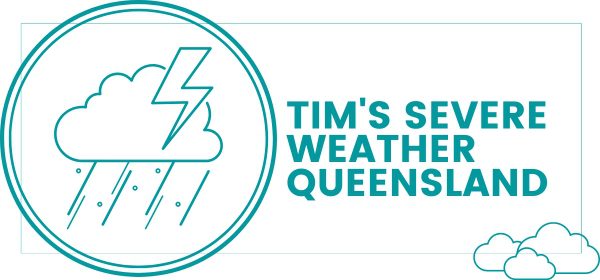Table of Contents
Have you ever heard of the Madden-Julian Oscillation (MJO) and wondered how it differs from El Niño and La Niña? This fascinating oceanic atmospheric phenomenon has significant implications for weather and climate patterns around the world.
From its characteristics and impact on tropical cyclones to its influence on Australian climate variability, the MJO plays a crucial role in shaping our environment.
Join us as we explore the nuances of the MJO and its implications for society and the environment.
Fast Facts and Stats
- The Madden-Julian Oscillation (MJO) is a tropical atmospheric phenomenon that affects weather patterns in the Pacific and Indian Oceans.
- MJO’s influence in Australia includes enhanced rainfall, increased cloud cover, and changes in temperature patterns.
- The Madden-Julian Oscillation (MJO) affects weather patterns in Australia for approximately 16 to 21 days per phase.
- MJO is characterized by an eastward-moving disturbance that propagates across the equator, typically lasting for 30 to 60 days.
- On average, the MJO brings a 25% increase in rainfall across northern and eastern parts of Australia during its active phase.
- Approximately 60% of tropical cyclones that develop in the Australian region can be influenced or triggered by the MJO.
- The Madden-Julian Oscillation contributes to up to 40% of the interannual precipitation variability in northern Australia.
- During an active MJO phase, temperatures in Australia can increase by up to 2 degrees Celsius above normal averages.
- MJO can have significant impacts on the Australian monsoon season and tropical cyclone activity.
- Understanding the behaviour of MJO helps meteorologists in predicting and monitoring weather patterns in Australia and surrounding regions.
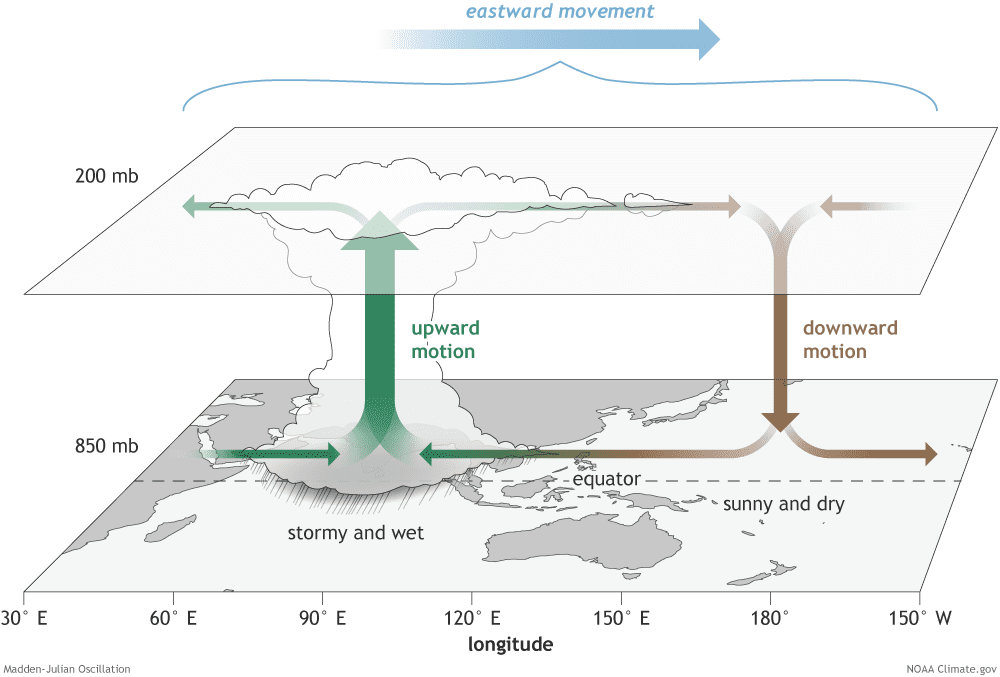
Madden Julian Oscillation – diagram – By Fiona Martin – https://www.climate.gov/news-features/blogs/enso/what-mjo-and-why-do-we-care, Public Domain, https://commons.wikimedia.org/w/index.php?curid=77318689
What Is the Madden Julian Oscillation (MJO)?
The Madden Julian Oscillation (MJO) is an Oceanic Atmospheric Phenomenon characterized by the eastward propagation of large-scale patterns of atmospheric convection and circulation.
The MJO plays a crucial role in modulating weather patterns across the globe by impacting the distribution of clouds, rainfall, and atmospheric pressure.
This phenomenon typically spans the equator and is associated with enhanced tropical convection, making it a key driver of the monsoon seasons in various parts of the world.
Its eastward movement is closely linked to changes in wind patterns and sea surface temperatures, influencing the occurrence of cyclones and other extreme weather events in different regions.
Scientists closely monitor the MJO to better understand its influence on regional climate variability and improve seasonal forecasting efforts.
How Is the MJO Different From El Niño and La Niña?
The Madden Julian Oscillation (MJO) differs from El Niño and La Niña by its shorter timescale, typically lasting between 30 to 60 days, and its focus on convective and circulation patterns rather than sea surface temperature anomalies like ENSO.
Contrary to El Niño and La Niña, the MJO’s influence on atmospheric conditions is more transient, leading to rapid changes in weather patterns across regions.
This eastward-moving pulse of cloud and rainfall affects not only the tropical climate but also has far-reaching impacts on global circulation systems. Understanding these distinctions is crucial for meteorologists and climatologists to predict and adapt to the dynamic variability in weather conditions driven by these phenomena.
What Are the Characteristics of the MJO?
The Madden Julian Oscillation (MJO) exhibits distinct characteristics such as large-scale atmospheric circulation patterns, various phases, tropical rainfall and convection, and specific wind patterns associated with each phase.
One of the key features of the MJO is its distinct phases, including the enhanced phase, where deep convection and atmospheric rising motion are prevalent, leading to increased cloudiness and precipitation. On the contrary, the suppressed phase experiences reduced rainfall and weaker convection.
The MJO has a significant impact on wind patterns across the tropics, influencing the strength and direction of the trade winds in different phases. Changes in wind patterns caused by the MJO can influence the development of tropical cyclones and other weather systems, making it a crucial factor in tropical meteorology.
Large-Scale Atmospheric Circulation Patterns
The Madden Julian Oscillation (MJO) influences large-scale atmospheric circulation patterns, impacting climate and weather conditions across different MJO phases.
During the MJO’s different phases, it can trigger shifts in the location of tropical rainfall and cloud cover, profoundly affecting global climate patterns. The enhanced convection associated with the MJO can lead to the development of tropical cyclones in some regions, while in others, it may suppress precipitation and alter temperature trends.
By modulating the distribution of heat and moisture in the atmosphere, the MJO plays a crucial role in creating variability in weather systems, influencing everything from monsoons to droughts.
Phases
The Madden Julian Oscillation (MJO) exhibits distinct phases that characterize the evolution of its convective and atmospheric patterns, impacting Australian weather and climate variability.
One of the primary phases of MJO is the ‘enhanced convection’ period, typified by increased thunderstorm activity and rainfall across tropical regions, including Australia. This phase brings about favourable conditions for tropical cyclone development and intensification in the Australian region. During this time, warmer sea surface temperatures are often observed, influencing regional atmospheric circulation patterns.
Conversely, there is the ‘suppressed convection’ phase of MJO when there is a decrease in thunderstorm activity and rainfall, leading to drier conditions in parts of Australia. This phase can have implications for agricultural activities, water resources management, and wildfire risks in the affected areas.
Tropical Rainfall and Convection
The Madden Julian Oscillation (MJO) plays a crucial role in modulating tropical rainfall and convection patterns by influencing wind flows and convective processes in the atmosphere.
Being a dominant mode of intraseasonal variability in the tropics, the MJO significantly affects the distribution of precipitation and cloudiness in the region.
Recurrent cycles of enhanced and suppressed convection associated with the MJO contribute to the development of large-scale atmospheric circulation patterns.
These convective activities impact not just local weather but also have far-reaching consequences on global climate by influencing energy exchanges and atmospheric dynamics.
Wind Patterns
The Madden Julian Oscillation (MJO) influences wind patterns through its interaction with atmospheric convection, playing a significant role in meteorological dynamics and convective patterns.
By modulating the distribution of convective activity across the tropics, the MJO creates a dynamic environment where wind patterns are constantly evolving. These fluctuations in wind direction and intensity can have far-reaching impacts on various weather phenomena, from tropical cyclone formation to monsoon dynamics.
Understanding how the MJO influences these wind dynamics is crucial for meteorologists to accurately predict and monitor weather patterns globally.
How Does the MJO Affect Weather and Climate?
The Madden-Julian Oscillation (MJO) impacts weather and climate by influencing tropical cyclone activity, modulating rainfall patterns, and affecting atmospheric circulation dynamics.
One of the key impacts of the MJO is its influence on tropical cyclones, which are intense rotating storms originating over warm tropical oceans. The MJO can either enhance or suppress tropical cyclone formation, leading to periods of increased or decreased storm activity in different regions.
The MJO’s effect on rainfall patterns is crucial as it can result in periods of heavy precipitation or prolonged dry spells, impacting agriculture, water resources, and ecosystems. The MJO plays a significant role in shaping atmospheric circulation patterns, influencing global weather systems and climate variability.
Influence on Tropical Cyclones
The Madden Julian Oscillation (MJO) influences tropical cyclones by modulating moisture convergence, wind patterns, and atmospheric instability, affecting the intensity and spatial distribution of cyclonic systems.
The MJO plays a crucial role in the behaviour of tropical cyclones, as it can either enhance or suppress their development depending on its phase. During the enhanced convective phase of the MJO, there is an increase in atmospheric moisture, leading to more favourable conditions for cyclone formation.
Conversely, during the suppressed phase, dry conditions prevail, inhibiting the development of cyclonic systems. The MJO also impacts the wind dynamics within the atmosphere, influencing the steering patterns that guide the movement of tropical cyclones.
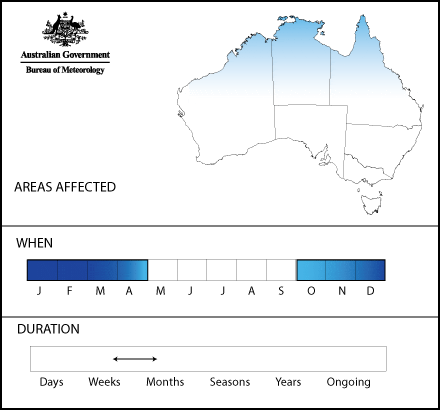
Image source: Bureau of Meterology
Impact on Monsoon Seasons
The Madden Julian Oscillation (MJO) exerts a significant impact on monsoon seasons by influencing rainfall patterns, circulation dynamics, and the onset of Australian monsoons.
Understanding how the Madden Julian Oscillation affects monsoon seasons provides valuable insights into the interplay between large-scale atmospheric processes and regional weather patterns. Through its cyclical movement across tropical regions, the MJO modulates the distribution of precipitation, leading to periods of enhanced rainfall in some areas and suppressed rainfall in others.
This oscillation also plays a crucial role in shaping atmospheric circulation patterns, influencing the strength and direction of winds that drive monsoonal flows. In the context of Australian monsoons, the timing of the MJO phases can dictate the onset and intensity of the wet season, impacting agricultural practices, water resources, and overall regional climate.
Effects on Global Temperature and Precipitation Patterns
The Madden Julian Oscillation (MJO) impacts global temperature and precipitation patterns by modulating atmospheric circulation, convective processes, and moisture transport across different phases.
The MJO plays a crucial role in shaping weather extremes such as heavy rainfall, droughts, and tropical cyclones by influencing the strength and position of the subtropical jet stream and the development of atmospheric disturbances.
During the active phases of the MJO, there is a higher probability of enhanced monsoon rains in regions like Southeast Asia and Australia, while the suppressed phases can lead to drier conditions over these areas.
The MJO’s interaction with other climate phenomena like the El Niño Southern Oscillation (ENSO) can amplify its impacts on global weather patterns, affecting not only seasonal rainfall distribution but also long-term climate trends.
What Causes the MJO?
The Madden Julian Oscillation (MJO) is primarily caused by the interaction between the ocean and atmosphere, driven by equatorial waves that propagate eastward along the equator.
Equatorial waves play a crucial role in triggering this intriguing atmospheric phenomenon, acting as the catalyst for the development of large-scale convective cloud patterns that travel across tropical regions.
These waves, formed by the interconnected interactions between the ocean and the air above it, act as the initial disturbance that initiates the MJO cycle. As these waves move eastward, they create areas of increased and decreased convection, resulting in the distinct wet and dry phases observed during the progression of the MJO.
Interaction Between the Ocean and Atmosphere
The Madden Julian Oscillation (MJO) is driven by the complex interaction between the ocean and atmosphere, influenced by various climate drivers and equatorial dynamics near the equator.
At the heart of the matter lies the intricate dance between the warm ocean waters and the overlying atmosphere, creating a dynamic duo that propels the MJO forward. This oscillation is not a solo act; it is orchestrated by a symphony of climate drivers, including sea surface temperatures, wind patterns, and atmospheric humidity.
As the MJO journey unfolds near the equator, equatorial processes come into play, shaping its trajectory and intensity. The interplay between convection, cloud cover, and atmospheric circulation sets the stage for this atmospheric phenomenon to make its presence felt across vast regions.
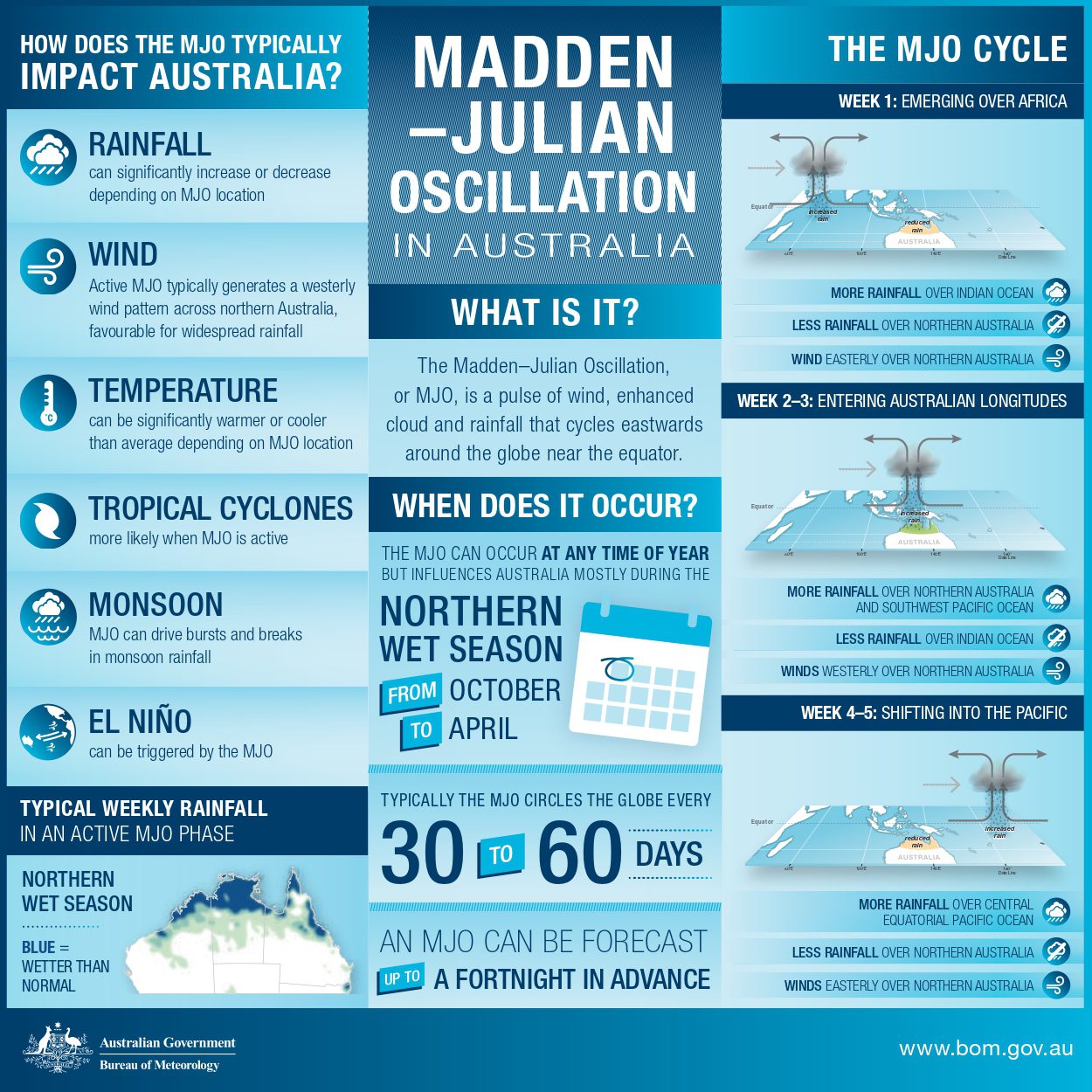
MJO-infographic
Infographic Courtesy of Bureau of Meteorology
Relationship with Equatorial Waves
The Madden Julian Oscillation (MJO) exhibits a relationship with equatorial waves, characterised by pulses of enhanced convection and circulation propagating along the equator, especially in the Pacific region.
These pulsating phenomena play a crucial role in driving the variability of weather and climate patterns in the tropics. Equatorial waves, closely tied to the MJO, contribute significantly to the overall atmospheric circulation and energy transfer across the tropical belt.
Accordingly, the interplay between the MJO and equatorial waves influences not only regional weather systems but also impacts global climate dynamics. This interaction showcases the interconnected nature of atmospheric processes, emphasising the intricate balance between convective activity and large-scale airflow patterns in the equatorial zone.
How Is the MJO Monitored and Predicted?
The Madden Julian Oscillation (MJO) is monitored and predicted using meteorological observations, satellite data, and climate models to forecast its phases and potential impact on weather patterns.
- Satellite data analysis plays a crucial role in providing detailed information on cloud cover, sea surface temperatures, and other atmospheric conditions associated with the MJO.
- Climate modelling techniques are utilised to simulate the behaviour of the MJO under different scenarios, aiding in predicting its future evolution and effects on regional climate.
One key method for monitoring the MJO involves analysing atmospheric pressure, winds, and rainfall patterns across the globe to track its movement and progression.
By combining these various tools and approaches, meteorologists can better anticipate the MJO’s behaviour and its implications for weather systems worldwide.
What Are the Implications of the MJO on Society and the Environment?
The Madden Julian Oscillation (MJO) has implications on society and the environment, affecting agriculture, food security, water resources, and other aspects of human well-being.
The MJO plays a crucial role in influencing weather patterns across different regions, impacting crop yields and agricultural practices. In regions where agriculture is a significant part of the economy, such as Southeast Asia or parts of Africa, the MJO’s effects on rainfall and temperature can greatly affect farmers’ livelihoods and food production. This oscillation can lead to fluctuations in crop growth, affecting food availability and prices in local markets.
The MJO can also influence water resources by affecting precipitation patterns and drought occurrences. Changes in rainfall patterns due to the MJO can lead to water scarcity in certain areas, impacting not only agriculture but also access to clean water for communities.
Agriculture and Food Security
The Madden Julian Oscillation (MJO) influences agriculture and food security through its impact on climate patterns, the timing of agricultural activities, and the intensity of environmental phenomena.
As the MJO moves eastward over the tropical regions of the globe, it can bring about significant changes in precipitation patterns, affecting the availability of water crucial for crop growth and livestock maintenance.
Farmers often rely on climate forecasts influenced by MJO phases to plan their planting and harvesting schedules, optimising their agricultural output. The MJO can influence the occurrence of extreme weather events, such as droughts or floods, which can have devastating effects on crops and food supplies.
Water Resources and Droughts
The Madden Julian Oscillation (MJO) influences water resources and drought conditions by acting as a key climate driver, shaping wind patterns and atmospheric moisture distribution across Australian regions.
The MJO, characterised by eastward and equatorward propagation of large-scale atmospheric circulation anomalies, plays a significant role in modulating rainfall variability and long-term climate trends in Australia. Its movement and intensity impact the initiation and progression of weather systems, ultimately affecting precipitation rates and water availability in different hydrological regions.
Air Quality and Pollution
The Madden Julian Oscillation (MJO) affects air quality and pollution levels in regions like Australia and the Maritime Continent by influencing atmospheric dynamics and convective processes in tropical areas.
The MJO plays a crucial role in modulating the distribution of precipitation and cloud cover, thereby impacting the concentration of pollutants in the atmosphere. This oscillation can lead to significant changes in wind patterns, which in turn affect the transport and dispersion of pollutants, ultimately influencing the air quality in these regions.
Understanding the MJO’s connection to air quality is essential for developing effective strategies to mitigate pollution and improve environmental conditions for the inhabitants of these areas.
Historical Significance of MJO Events in Australia
The historical significance of Madden Julian Oscillation (MJO) events in Australia is reflected in their impact on rainfall patterns, temperature variations, and Australian climatic conditions over the years.
These atmospheric phenomena play a crucial role in modulating the timing and intensity of monsoonal rains in Australia. During active MJO phases, there is a higher likelihood of above-average rainfall in northern Australia, while the central and southern regions experience drier conditions.
The influence of MJO events extends beyond just precipitation patterns; they also contribute to temperature fluctuations across the continent. Warm and cool phases of the MJO can lead to anomalous temperature responses, affecting both daytime highs and nighttime lows.
MJO and Australian Climate Variability
The Madden Julian Oscillation (MJO) plays a significant role in Australian climate variability, providing essential data and information on rainfall patterns and meteorological dynamics across the region.
Due to its cyclical nature, the MJO influences the timing and intensity of monsoons in Australia, impacting agricultural practices and water resource management.
By studying the MJO’s phases and movement, meteorologists can predict changes in weather patterns, helping farmers and policymakers make informed decisions to mitigate potential risks.
Understanding the behaviour of the MJO is crucial for accurate long-term climate forecasting, as it serves as a crucial indicator of shifts in precipitation levels and atmospheric circulation in the Australian region.
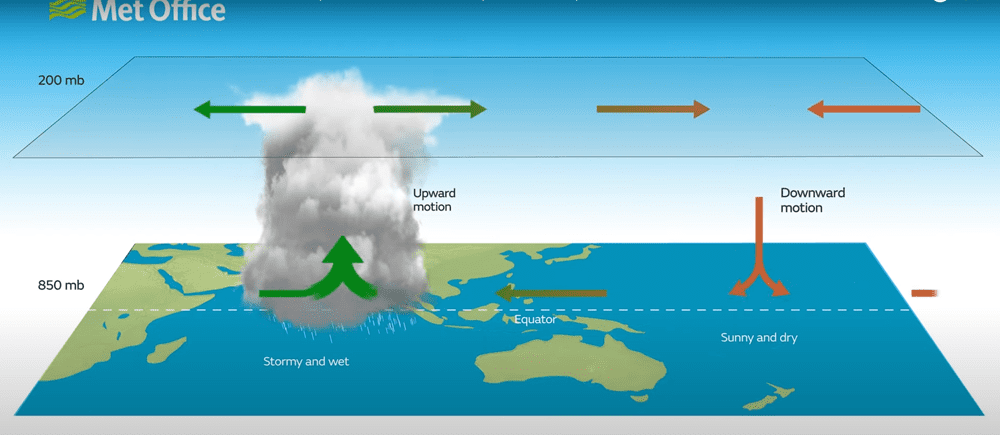
MJO and Rainfall Patterns in Australia
The Madden Julian Oscillation (MJO) influences rainfall patterns in Australia by affecting the location of precipitation, guiding forecast models, and prompting weather warnings in specific regions. By analysing the behaviour of the MJO, forecasters can anticipate shifts in weather patterns and issue timely alerts to regions at risk of flooding or drought.
Future Research and Implications for Australia’s Climate
Future research on the Madden Julian Oscillation (MJO) aims to enhance climate forecasting capabilities, improve our understanding of regional climate dynamics, and refine map observations for areas like Queensland.
Innovative approaches could involve integrating machine learning algorithms with climate models to better predict MJO patterns. Exploring the teleconnections between MJO and other climate phenomena like El Niño could offer valuable insights into broader climate variability.
Advances in satellite technology could also provide more detailed observational data to enhance our understanding of the MJO’s influence on specific regions. Collaborative efforts among climate scientists, meteorologists, and data analysts will be essential to drive these future research directions forward.
Frequently Asked Questions
What is the Madden Julian Oscillation (MJO)?
The Madden Julian Oscillation (MJO) is an oceanic atmospheric phenomenon that describes the eastward movement of large-scale atmospheric circulation in the equatorial regions of the Indian and Pacific Oceans.
How does the MJO impact weather patterns?
The MJO can have significant impacts on global weather patterns, including changes in precipitation, temperature, and wind patterns. It can also influence the occurrence of extreme weather events, such as hurricanes and droughts.
What causes the MJO?
The MJO is primarily caused by the interaction between the atmosphere and the oceans, specifically the coupling between the ocean surface and the overlying air. This interaction is influenced by factors such as temperature, moisture, and wind patterns.
How often does the MJO occur?
The MJO is a recurring phenomenon that can occur multiple times in a year. It typically lasts for 30-60 days and can have a significant impact on global weather patterns during this time.
Can the MJO be predicted?
While the MJO is a natural and recurring phenomenon, it can be challenging to predict due to its complex interactions with other atmospheric and oceanic patterns. However, advances in technology and forecasting techniques have improved the accuracy of MJO predictions in recent years.
How does the MJO affect tropical cyclones?
The MJO can play a significant role in the development and intensity of tropical cyclones. It can enhance or suppress the formation of these storms, depending on the phase and strength of the MJO. This information is vital for hurricane forecasting and preparation.
How does the MJO affect the weather in Australia?
The Madden-Julian Oscillation (MJO) affects Australian weather by influencing rainfall patterns, especially in northern Australia. It can enhance the Australian monsoon, leading to increased rainfall during its active phases.
Are there any links between the MJO and extreme weather events in Australia?
Yes, the MJO can contribute to extreme weather events in Australia, such as heavy rainfall, cyclones, and flooding, particularly in northern regions.
Are there any forecasting tools available to monitor and predict the behaviour of MJO in Australia?
Yes, several forecasting tools, such as the Real-time Multivariate MJO (RMM) index and the Wheeler-Hendon Climatology, are used to monitor and predict the behaviour of the MJO in Australia.
Who discovered the Madden-Julian Oscillation?
The Madden-Julian Oscillation was discovered by American atmospheric scientists Roland Madden and Paul Julian in 1971.
Who studies the impact of MJO on weather patterns in Australia?
Meteorologists and climatologists, particularly those working at research institutions and meteorological agencies, study the impact of the MJO on weather patterns in Australia.
Who can provide historical data on MJO events in Australia?
Meteorological agencies and research institutions, such as the Australian Bureau of Meteorology and academic research centres, can provide historical data on MJO events in Australia.
Where can I find real-time updates on the Madden-Julian Oscillation in Australia?
Real-time updates on the Madden-Julian Oscillation in Australia can be found on the websites of meteorological agencies, such as the Australian Bureau of Meteorology, and through specialized meteorological data services.
Where can I find articles or publications discussing the Madden-Julian Oscillation in relation to Australia?
Articles and publications discussing the Madden-Julian Oscillation in relation to Australia can be found here on Tim’s Severe Weather, in scientific journals, in research papers, and on the websites of meteorological agencies and research institutions.
🌐 Article Sources & Resources
- Bureau of Meteorology – Madden-Julian Oscillation (MJO) monitoring: This official resource provides comprehensive monitoring and information on the Madden-Julian Oscillation (MJO) with detailed maps and graphs.
- Bureau of Meteorology – About Australian Climate: Learn more about the MJO’s impact on Australian climate and its characteristics from this Australian government website.
- Wiley Online Library – The Link Between the Madden‐Julian Oscillation and Rainfall Trends in Northwest Australia: This research article discusses the link between the MJO and increasing rainfall trends in northwest Australia.
- Climate Change in Australia – Australian climate influences: Explore how the MJO influences rainfall patterns in Australia and its connection to the Australian monsoon.
- NOAA Physical Sciences Laboratory – PSL MJO Research: This resource offers in-depth information on the MJO index diagrams, atmospheric variables, and its impact on global weather patterns.
- Springer – Madden–Julian Oscillation teleconnections to Australia: This research article examines the MJO’s impacts on Australian springtime temperatures and extremes.
- Victoria State Government – Understanding Weather, Climate, and Forecasting: Learn about the MJO’s influence on Australia’s weather and climate, especially during the warmest months of the year.
- National Drought Forum 2003: Science for Drought: This forum discusses the MJO’s impact on Queensland’s rainfall and its use in developing rainfall forecasts.
- Tropical Cyclones
